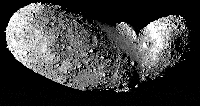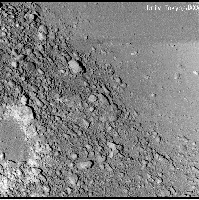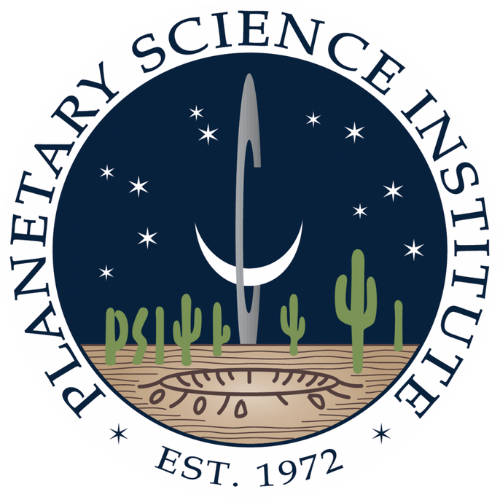
Eastern side of Itokawa showing both smooth and rough terrains. The longest axis of Itokawa is about 500m.
April 19, 2007: Unprecedentedly high-resolution images from the Hayabusa spacecraft, the first Japanese asteroid mission, show unexpected evidence of the migration of gravels covering the surface of asteroid Itokawa.
Hirdy Miyamoto (an Affiliate Scientist of PSI and an Associate Professor of University of Tokyo), Bob Gaskell (a Senior Scientist of PSI), and others studied the Hayabusa’s high-resolution images with up to 6mm/pixel resolution and discovered that Itokawa was covered with unconsolidated millimeter-sized and larger gravels. The finest granules are in pebble size and are found only in the smooth-looking terrains that cover 20% of the surface. This is surprising because impact ejecta on a small asteroid is expected to spread globally over its surface resulting in continuous regolith. In a paper being published today in the journal Science, Miyamoto, Gaskell, and others propose that unconsolidated gravels have globally migrated and segregated due to fluidization caused by vibrations likely induced by impacts of small meteoroids.

Close-up image between rough and smooth terrain. Note the alignments of boulders from left top to right bottom, indicating that gravels migrate into the direction of left bottom to right top. This is consistent with that the boulder at the center of this image is partly covered by fines. White circle on the left is a crater with its disrupted rim.
The key morphological evidence for the gravel migration is how gravels align in very close-up images. The directions of the longest axes of gravels might be randomly distributed if they are simply accumulated. However, statistic analyses based on mapping of the gravels indicate that Itokawa’s gravels are generally aligned. Deposits of terrestrial riverbed or landslides often show similar alignments. The directions of these asteroidal gravel migrations exactly coincide with the directions of local gravitational slopes.
When gravel is vibrated, it can be fluidized and behave as granular fluid. The most popular phenomenon related to this is called the “Brazil nut effect”—the biggest particles end up on the surface when granular material is shaken. Thus, the stranding of boulders covering the rough terrain of Itokawa may have occurred as a result of this process. Granular processes may be a major resurfacing mechanism for all small asteroids possessing regolith.
Contacts
Hirdy Miyamoto
Planetary Science Institute/The University Museum, University of Tokyo;
Tel/Fax +81-3-5841-2830
hm [at] um.u-tokyo.ac.jp
http://www.um.u-tokyo.ac.jp/hp/miyamoto/e.html
Dr. Robert Gaskell
Planetary Science Institute
Tel: 520-622-6300
rgaskell [at] www.psi.edu
Related Paper
Authors: H. Miyamoto, H. Yano, D. J. Scheeres, S. Abe, O. Barnouin-Jha, A. F. Cheng, H. Demura, R. W. Gaskell, N. Hirata, M. Ishiguro, T. Michikami, A. M. Nakamura, R. Nakamura, J. Saito, S. Sasaki
Journal: Science
Published: May 18, 2007
DOI: 10.1126/science.1134390
Ref: Miyamoto, H., Yano, H., Scheeres, D. J., et al. “Regolith Migration and Sorting on Asteroid Itokawa.” Science, 316.5827 (2007).

